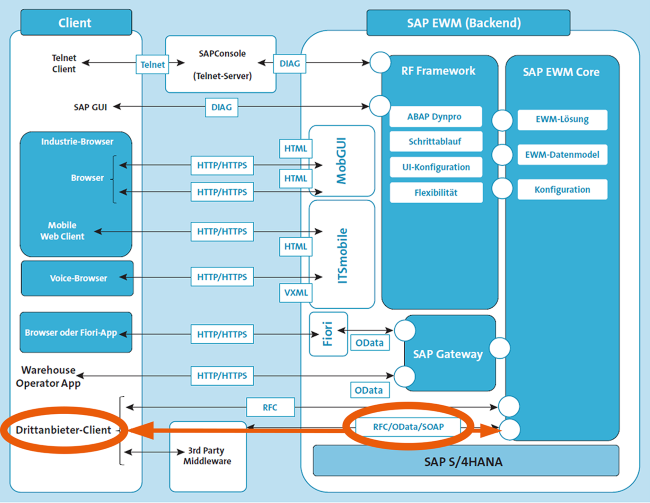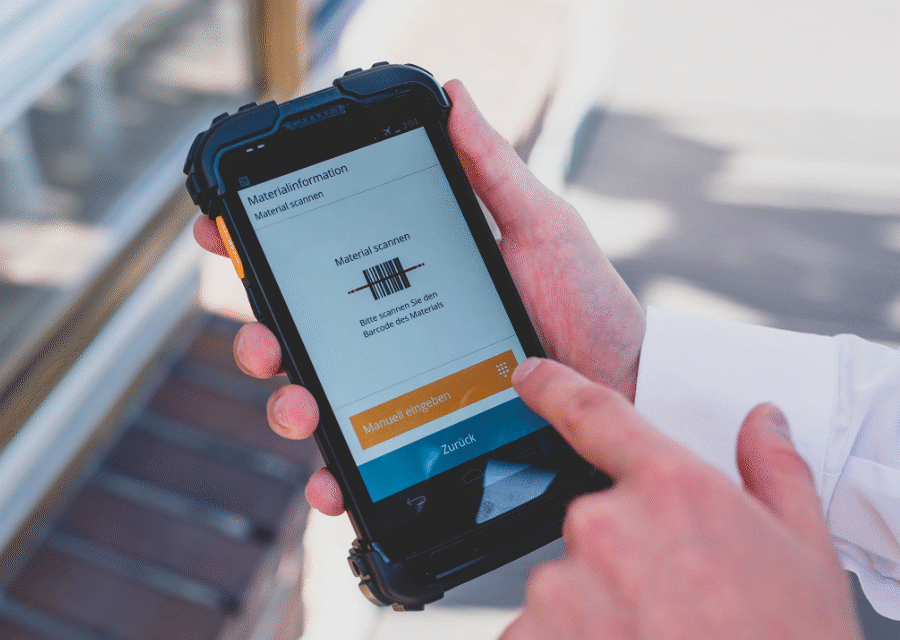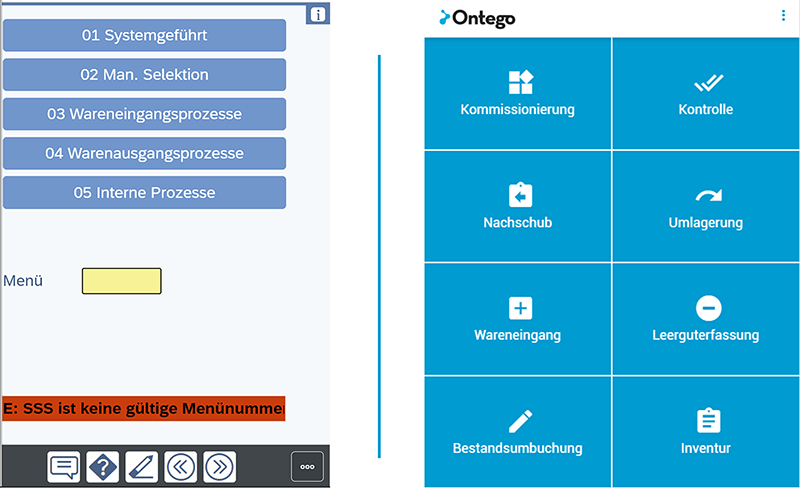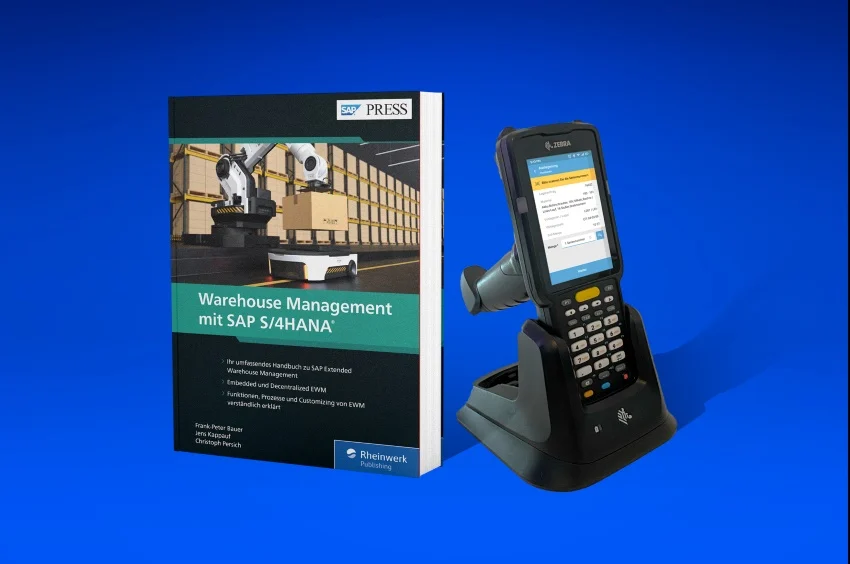Topics
“Warehouse Management with SAP S/4HANA” is the standard reference work on SAP EWM. The fourth edition focuses specifically on EWM in the S/4HANA context. We took a look at the book, paying particular attention to mobile processes. Read on to find out why the book is valuable and where there are gaps.
SAP Extended Warehouse Management – SAP EWM for short – is SAP's strategic product for warehouse management. That is the clear statement made by the authors in the introduction. SAP EWM has been on the market for a long time. Since 2005, SAP has been offering SAP EWM as a solution for scalable warehouse management.
However, with the switch to S/4HANA, more and more companies are opting to use SAP EWM. This is also because SAP does not strategically market the alternatives.
This makes a guide all the more important for companies planning to introduce SAP EWM or already using EWM. The book offers this guide with a comprehensive introduction to implementation options, functionalities, processes, and system settings.
1,000 Pages Full of SAP EWM Know-How – wow!
What is the value of the book? The book is a compendium. A reference work. A guide. A companion for the introduction and productive use of EWM.
The first edition was published in 2010. At that time, the focus was still on the importance of speed and reliability of deliveries, as stated in the foreword by Florian Kuchta, Head of Product Management Extended Warehouse Management at SAP.
The following editions trace the evolution of EWM: from the integration of industry-specific requirements (2nd edition) and the individualization of products down to batch size 1 (3rd edition) to the latest edition: the integration of EWM into the S/4HANA Suite.
Here are a few facts about the book:
- Year of publication: 2023 (4th edition)
- Authors: Frank-Peter Bauer, SAP EWM Project Manager; Jens Kappauf, Supply Chain Management Expert; Christoph Persich, WM and EWM Expert at SAP
- Publisher: Rheinwerk (SAP Press)
- 1,276 pages
- Target audience: IT management, project management, process consulting, users
- Link to the book
What is the goal of Bauer, Kappauf, and Persich with their SAP EWM book?
According to their own statement, they are writing a guide for the implementation of logistics processes using SAP EWM. EWM is extremely powerful (my own comment: for some companies, certainly too powerful, as our discussions repeatedly show).
What does Extended Warehouse Management do? EWM organizes, controls, and monitors the physical movement of goods in the warehouse, including complex processes such as cross-docking, yard management, and additional logistics services.
The foundation for warehouse processes in S/4HANA is also central inventory management in the ERP system; master data management also remains in SAP ERP, although the latter has been significantly simplified and made more efficient in S/4HANA, as the authors explain using examples such as the business partner concept and the elimination of redundant documents.
Mobile EWM Processes & SAP Standard Tools
What do the authors actually say about mobile warehouse processes? In other words, the processing of warehouse tasks using handheld or forklift terminals? The topic of this SAP Mobility Blog?
In chapter 13 (of 17), they devote 74 pages to the topic. The authors focus exclusively on the integrated capabilities of SAP and SAP EWM. This is unfortunate because it means that alternative, tried-and-tested, contemporary approaches to mobile EWM apps for logistics specialists, SAP key users, and IT managers are not covered. And they are implicitly presented as irrelevant (even though there are alternatives for mobile SAP EWM processes).
Important aspects are:
- SAP GUI for GUI-based devices and workstations
- SAPConsole for text-based devices
- ITSmobile for web-based and graphical display as well as pick-by-voice and RFID integration
- SAP Screen Personas/EWM MOBGUI
- SAP Fiori is currently used primarily on tablets. SAP does not intend or recommend the use of SAP Fiori on mobile handheld devices.
- The SAP Warehouse Operator app for Apple iPhone
- Integration of non-SAP systems through the use of interfaces (APIs), such as Remote Function Call (RFC) or web services

Source : Warehouse%20Management%20with%20SAP%20S/4HANA%20%u2013%20commented%20on%20by%20commsult
What can we glean from this list? The list clearly reflects the SAP consultant's perspective. This is understandable from the authors' point of view. From a consultant's perspective, mobile processes are a niche topic – which is also understandable when you consider the complexity of SAP EWM customizing. At the same time, they recognize and emphasize the individuality of mobile projects...
Nevertheless, it is a shame that the book focuses on approaches that are outdated from a technical perspective (ITSmobile, SAP Console), inflexible (SAP Screen Personas), or not very user-friendly (EWM MOBGU) – and leaves out the exciting world of alternative app-based approaches.
Experience from many projects shows that the dialog sequence of applications in warehouse logistics itself can never be standardized.
— Bauer, Kappauf, and Persich
SAP EWM – Embedded or Decentralized?
But back to the book. Following the idea of a guide, the authors explain fundamental aspects of implementing SAP EWM in detail and with technical support in chapters 2 to 7. A must-read for any reader who is considering, planning, or implementing EWM.
In the context of S/4HANA, the options range from integration as a central warehouse management system (embedded) integrated into the ERP to decentralized connection to the ERP.
- The “embedded variant” offers simple warehouse management or extended warehouse management.
- The decentralized option is ideal if warehouse processes need to be scalable and high-performance.
In addition, companies are faced with the question of whether the EWM system should be set up on-premise in their own data center or in the SAP Cloud (either private or public). The authors' suggestions for decision-making criteria offer practical guidance to the reader.
Customizing Warehouse Structures in S/4HANA and EWM
Readers learn how to map a warehouse organizational structure in S/4HANA and correspondingly in EWM (Chapter 3), including the necessary settings. These include the organizational elements company code, plant, storage location, warehouse number, and shipping point in ERP, as well as the SAP EWM elements warehouse number, storage type, storage area, storage bin, activity area, work center, goods receipt office, and shipping office.
The quality of master data is crucial for a successful EWM implementation. We can only agree with this point – correct master data is also essential for error-free mobile EWM solutions.

Learn everything about modern mobile SAP apps in warehouse and production.
The authors rightly devote a separate chapter (4) to master data. In almost 100 pages, they also discuss the different types of inventory, their significance and benefits, and the functions of the SAP EWM system for inventory management (Chapter 5).
Delivery Processing – a Central Element in EWM
The authors emphasize that one of the central components of SAP EWM is delivery processing (chapter 7). It manages basic documents for processing goods receipts, goods issues, returns, and stock transfers.
Delivery processing also forms the interface for connecting external order management, e.g., an S/4HANA system. Chapter 8, which covers the basics of process control, rounds off this part of the book. It explains wave management, the concept of warehouse tasks in EWM (instead of the transport orders familiar from SAP WM) and their bundling into warehouse orders, as well as the mechanisms of warehouse control and the resulting possibilities for process automation.

EWM for All Warehouse Logistics
Let's remember: the compendium comprises 1,000 pages. Of course, the handling of specific warehouse processes is also described in detail. From goods receipt to storage, goods movements in the warehouse to goods issue – the authors devote themselves to logistics processes, partly in separate chapters and partly in collective sections.
Incidentally, the explanations on the integration of production logistics using EWM and those on quality inspection are new.
The EWM experts also cover special topics, including additional logistics services, kit formation, cross-docking, form printing, and integration with other SAP products. Reporting of logistics key figures is given its own chapter, as are migration to S/4HANA and SAP EWM.
RF Framework – The Preferred SAP Option
Another special topic is mobile working in the warehouse, for example using scanner solutions. For SAP EWM, this involves the SAP-integrated Radio Frequency Framework and the RF transactions it contains. More on this in a moment.
Before implementing a mobile warehouse solution, it is necessary to set up basic mechanisms in SAP EWM. The central mechanism is SAP EWM resource management. This allows a company to map both employees and work equipment (e.g., forklifts) in the system.

Source : Mobile solutions with SAP EWM RF dialog vs. third-party client using the example of Ontego
The SAP approach is to configure as many parameters as possible in warehouse management. This goes so far that SAP EWM also provides default settings for mobile screen ratios in warehouse management (two layouts available for forklift terminals and handhelds).
Queue control plays a central role in the efficient processing of mobile processes. The variants and their setup are described in detail. EWM offers a wide range of options in Customizing for optimizing warehouse processes, for example, through automatic queue determination or system-guided work, or other functions such as double play or resource execution constraints.
RF Framework is Complex
But back to the RF framework. Its presentation takes up a lot of space. The authors explain that using RF can be very complex at first, for example, when new transactions have to be developed. There is a steep learning curve for newcomers. At the same time, it offers flexibility, for example, through specific screen sequences.
SAP Fiori currently plays no role in the mobile/RF environment in warehouses, as too few transactions are currently available in the SAP standard.
— Bauer, Kappauf, and Persich
Unfortunately, the book's presentation of mobile warehouse processes is narrowly focused on the SAP perspective. Third-party solutions based on modern app technologies are marginalized.
A quote from the book: “In summary, based on the points raised, it can be said that the mobile strategy in a warehouse cannot ignore the SAPConsole, ITSmobile, and EWM MOBGUI technologies. Warehouses that operate with third-party applications must take higher IT costs into account. In addition, there are very few customers who use this technology in their warehouses.”
SAP-Technologien für MDE-Lösungen - das Nonplusultra?
This is the view of SAP consultants and may be appropriate for some companies. There is no question about that.
However, those who want to focus less on system logic and more on physical process requirements in their discussions about mobile warehouse solutions should definitely consider a third-party solution.
And: The fact that only a few customers have used third-party solutions so far will be relativized in the medium term with the increasing spread of EWM systems.
In addition, Bauer, Kappauf, and Persich also point out challenges.
For example, securing WLAN interruptions (according to the authors, one of the most important functions of a mobile solution). When using the technologies promoted in the book, this can only be achieved with separate, special industrial browsers that can display and partially buffer the generated HTML web pages.
In our view, an optimized mobile solution should always take into account the requirements dictated by physical processes. These may well deviate from the SAP EWM system logic or integrate both sensibly into one app.
In addition, the authors address further limitations that, from a logistics perspective, may well argue in favor of a third-party solution:
- “SAP EWM itself does not yet offer support for optimally connecting devices without function keys to the SAP EWM system.” This rules out the use of full-touch devices or makes it possible only at increased expense.
- "... EWM MOBGUI is currently only interesting in a cloud environment." In addition, the technology has only been tested with the Zebra MC9300 and a specific industrial browser.
- “Experience also shows that SAP Fiori is not yet recommended on mobile devices from a performance perspective. In the context of SAP EWM, there are still no plans to provide SAP Fiori apps for mobile devices as standard.” In case of doubt, this means deviations from a Fiori-only strategy or high development costs.
In addition to mobile warehouse solutions, other possibilities for optimizing EWM processes are also interesting. The authors describe the use of pick-by-voice via RF, RFID-controlled processes, the use of wearables, and the connection of scales.
Conclusion
“Warehouse Management with SAP S/4HANA” is a comprehensive presentation of warehouse management with SAP EWM. The contents of the book, together with the many references to further SAP notes, provide a sound introduction to logistics management with EWM and specifically under S/4HANA. The topic of mobile SAP warehouse solutions, which we consider relevant, is described in a somewhat one-sided manner. According to the authors of the book, only SAP's on-board tools are recommended for mobile logistics processes.
Our recommendation at this point is to examine both RF and other approaches and choose the solution that best suits your specific logistics requirements. With the increasing number of OData services for EWM-managed warehouse processes, the scope for modern EWM scanner solutions is constantly expanding.




.jpg)